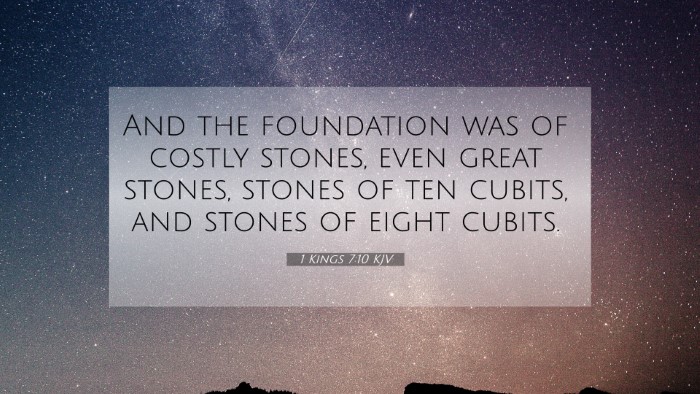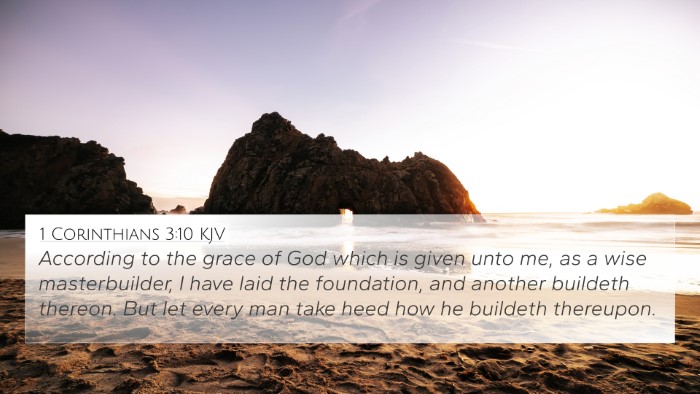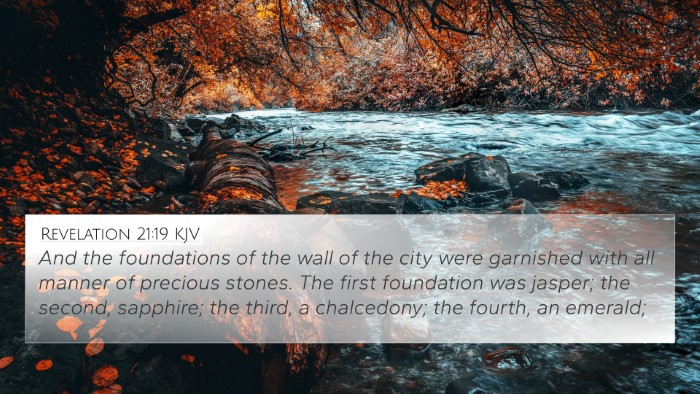Meaning and Interpretation of 1 Kings 7:10
The verse 1 Kings 7:10 states: "And the thickness of the stones was ten cubits, according to the measure of the stones that were cut, and the height was five cubits; and the stones to be cut, to the measure of the house." This passage highlights the dimensions and quality of the materials used in the construction of the Temple by Solomon, emphasizing meticulous planning and craftsmanship.
Summary of Insights from Public Domain Commentaries
Matthew Henry's Commentary
Matthew Henry emphasizes the significance of the dimensions provided in this verse as indicative of both the grandeur and permanence of the Temple. The meticulous detail serves to showcase God's glory and the importance of worship in a sacred space. Henry notes that the impressive nature of the stones reflects the attention given to the construction—both physically and spiritually—illustrating how the Temple is not merely a building but rather a place of divine presence.
Albert Barnes' Notes
Albert Barnes remarks on the architectural precision depicted in this verse. He provides a comparative analysis, linking it to the broader context of the Temple's construction, which was to be a magnificent dwelling place for God. Barnes highlights how these dimensions tie back to the standards set forth in Exodus, showing a continuity of divine instruction and human workmanship. The mention of 'cut stones' implies both labor and intention, underscoring the necessity of quality in worship.
Adam Clarke's Commentary
Adam Clarke provides further elaboration on the nature and intention behind the specifics in this verse, pointing out that the call for precision reflects the importance of order and beauty in God's house. Clarke makes connections with the concept of the spiritual temple in the New Testament, suggesting that the physical Temple foreshadows the eternal dwelling place of believers with God. This duality of meaning resonates throughout Scripture, aligning with the theme of God's desire for a relationship with humanity.
Bible Verse Cross-References
- Exodus 27:1-2: Describes the construction of the altar, emphasizing quality and dimensions reflective of holiness.
- 1 Chronicles 22:14: Highlights the preparations made for the Temple, noting the extensive resources collected for construction.
- 2 Samuel 7:13: Points to the permanency of Solomon's house as a lasting dwelling for God's name.
- 1 Kings 6:14: Earlier verses that describe the interior of the Temple, emphasizing the holiness and grandeur of the structure.
- Ezekiel 40:2: Provides a prophetic vision of a future Temple, making thematic comparisons with dimensions and design.
- Hebrews 9:24: Indicates the true heavenly sanctuary, a spiritual parallel to the physical Temple described in Kings.
- Revelation 21:22: References the New Jerusalem where no Temple is needed, as God and the Lamb are its light, connecting to the earthly Temple's purpose.
Thematic Connections and Symbolism
This verse serves as a vital point of connection between various scriptural themes. It reflects the importance of God's presence among His people, celebrated through the Temple's construction. The detailed measurements symbolize divine order and purpose, serving as a precursor to understanding the nature of God's dwelling place, both in the physical and spiritual realms.
Understanding Through Cross-Referencing Biblical Texts
Cross-referencing tools are invaluable for in-depth Bible study. By examining the interconnectedness of verses, readers can grasp holistic themes within Scripture, deepening their understanding of how God communicates through the narrative of His people. Studies that employ a Bible concordance or a cross-reference Bible study method can reveal rich insights about God's plans and promises throughout biblical history.
Conclusion
The importance of 1 Kings 7:10 cannot be overstated as it encapsulates a significant moment in biblical history. Understanding the soundness of the construction and the underlying theological implications reveals much about God's relationship with His people. By exploring cross-references, one discovers the layers of meaning within God's Word, illustrating the breadth of His designs in both physical and spiritual domains.






